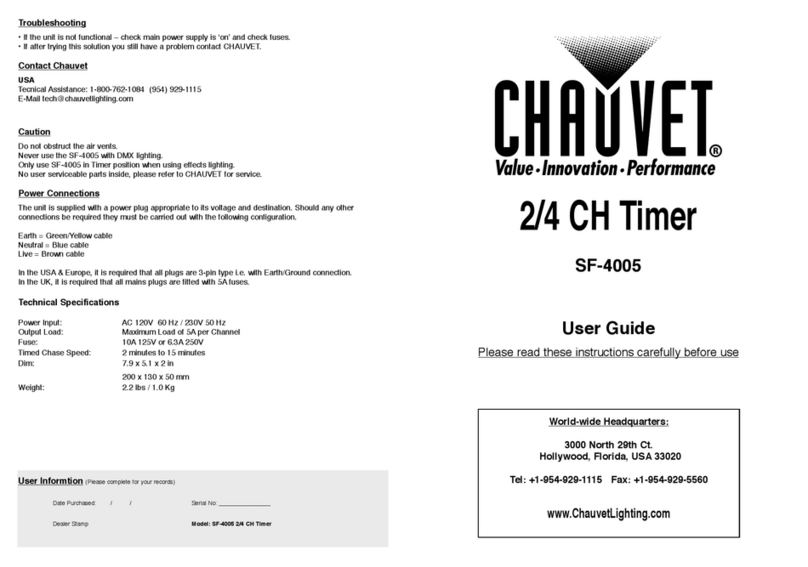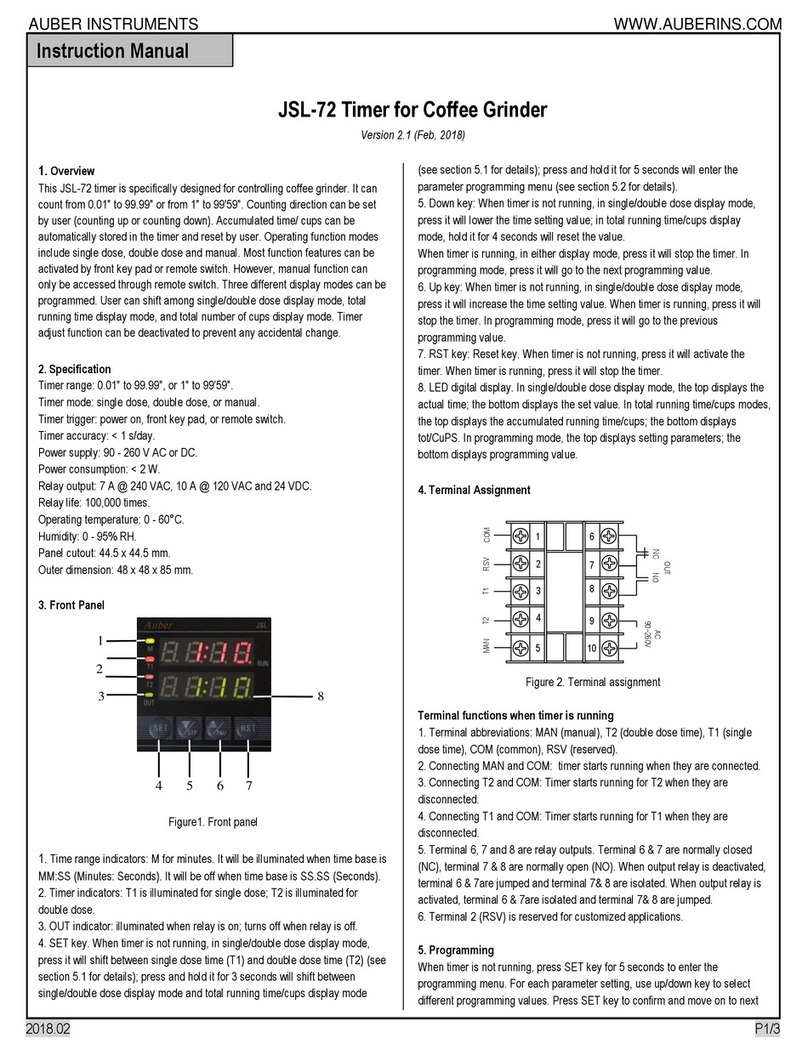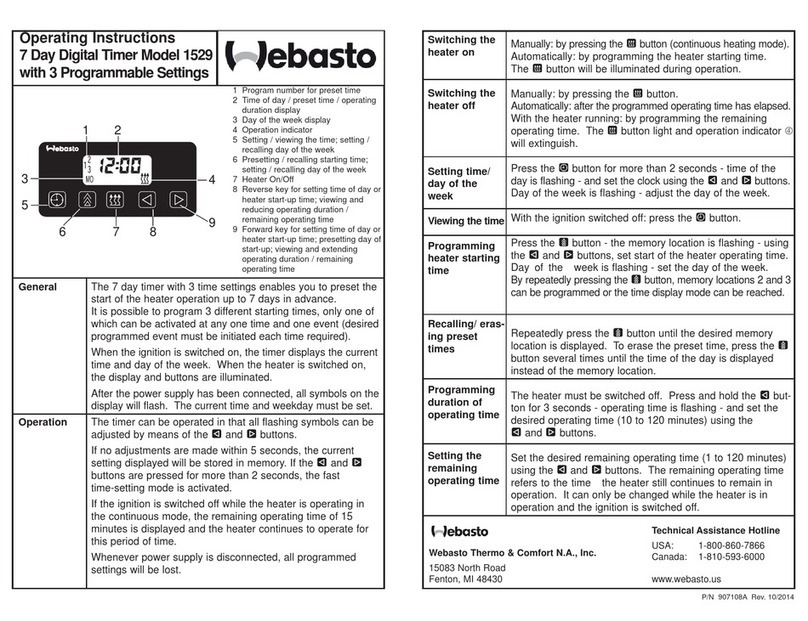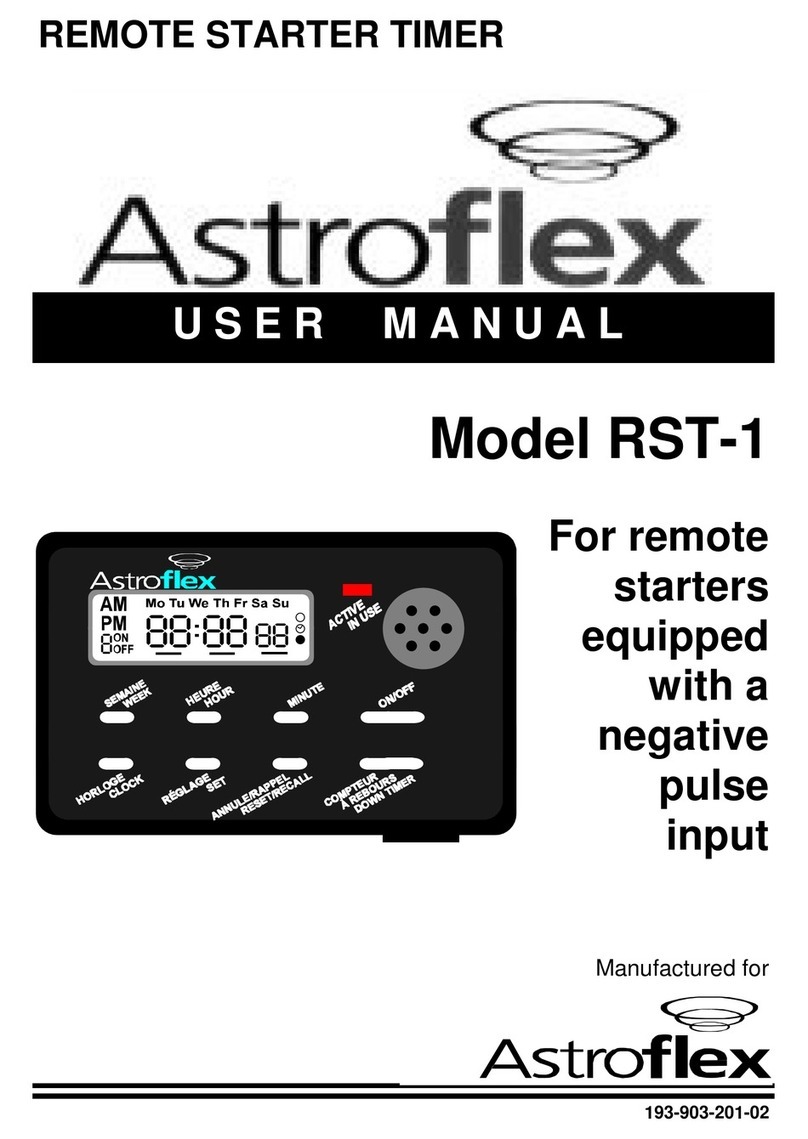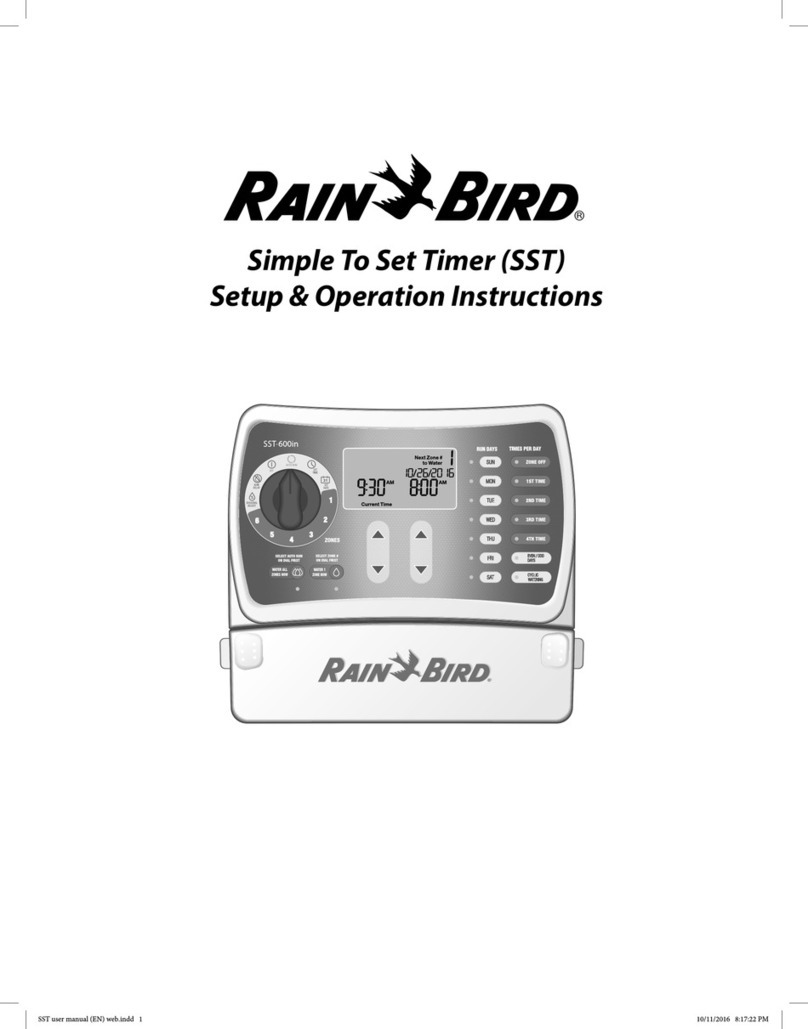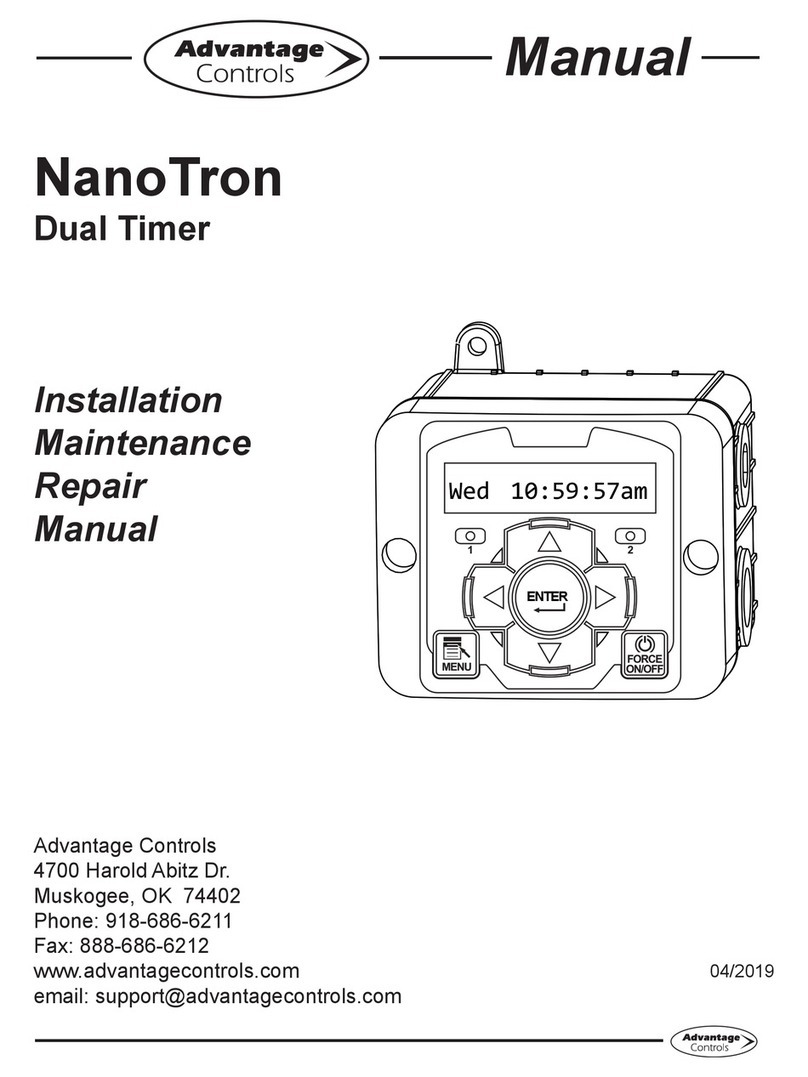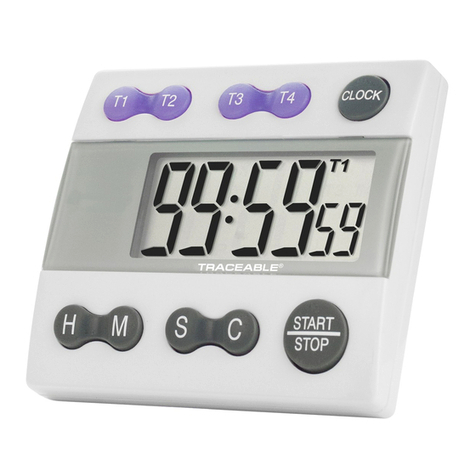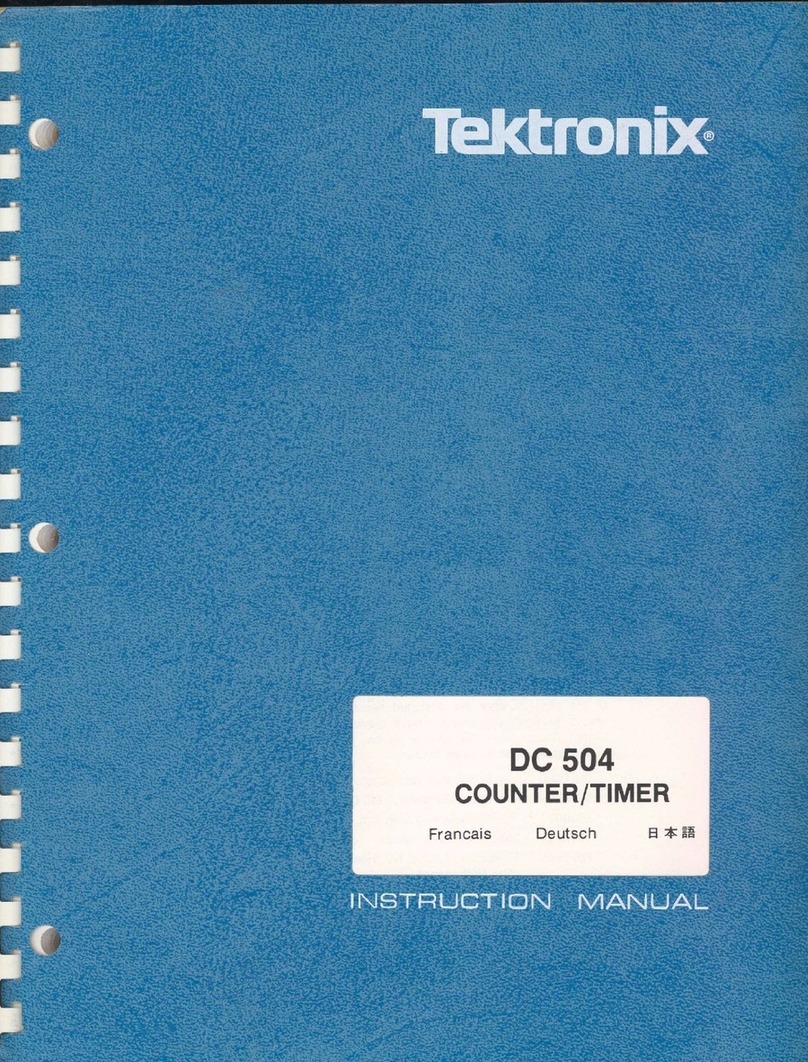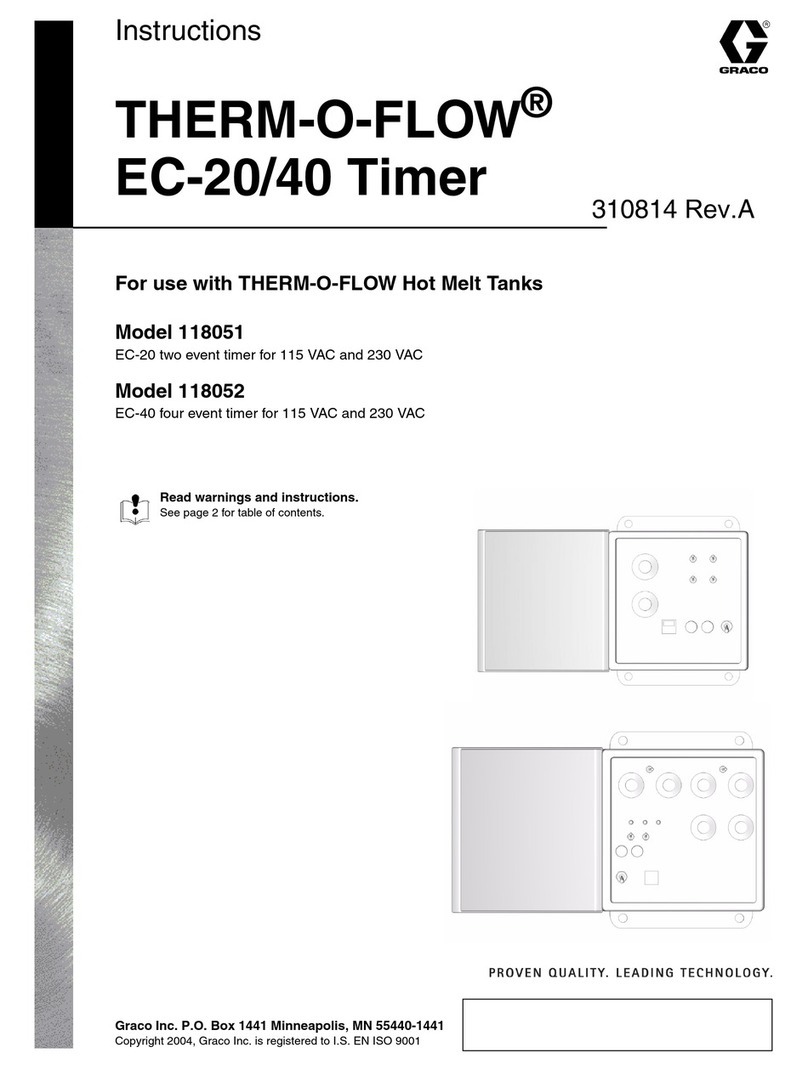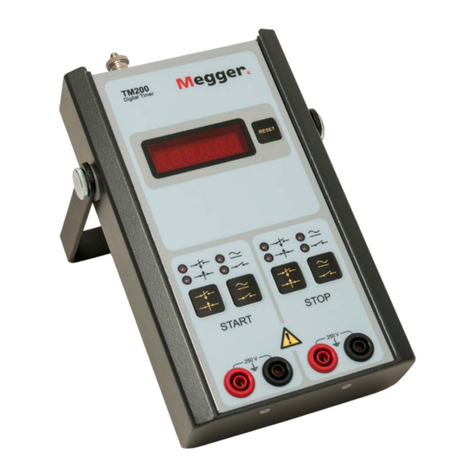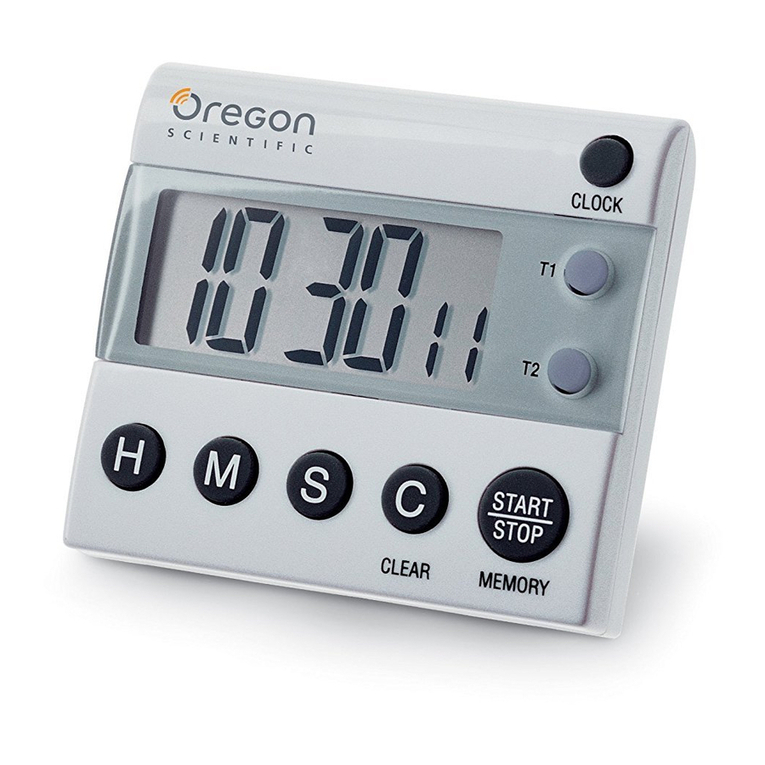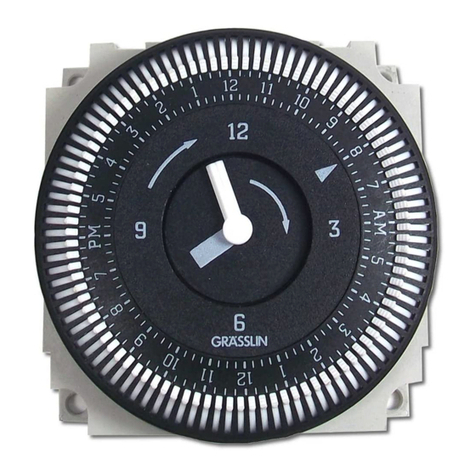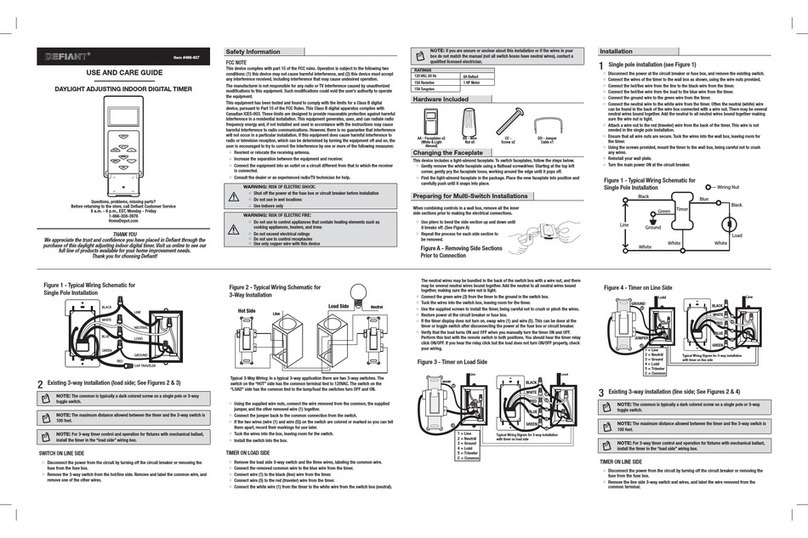Greiner Bio-One Sed Rate Timer 10/II User manual

SRT 10/II
USER MANUAL
page 1 of 37
Sed Rate Timer 10/lI (SRT10/II)
including Software (G2M110BO, Vers. 1.1)
ESR Analyzer
(optional thermal printer available)
USER'S MANUAL
MAN-003 –Revision 09
Revision date: January, 2019

SRT 10/II
USER MANUAL
page 2 of 37
This user manual follows the directions as prescribed by the CEN/TC 140
recommendations for in -vitro diagnostic instruments:
INSTRUMENT NAME: Sed Rate Timer 10/II (SRT 10/II)
including Software (G2M110BO, Vers. 1.1)
Short cut name: SRT 10/II
Automatic Sed-Rate analyzer,
10 measuring channels
Greiner Bio-One GmbH
Bad Haller Straße 32
A-4550 Kremsmünster
AUSTRIA
Tel.: +43 (0)7583 6791-0
Fax.: +43 (0)7583 6318
PLEASE READ THIS ENTIRE PRODUCT MANUAL
BEFORE USING THE INSTRUMENT FOR THE FIRST TIME.

SRT 10/II
USER MANUAL
page 3 of 37
CONTENTS
1. INTRODUCTION........................................................................................................................................... 5
1.1 INTENDED USE........................................................................................................................................... 5
2. POTENTIAL DANGERS AND SAFETY PRECAUTIONS............................................................................ 5
2.1 USER PRECAUTIONS.................................................................................................................................. 5
2.2 ELECTRICAL EQUIPMENT ............................................................................................................................ 5
2.3 MECHANICAL EQUIPMENT ........................................................................................................................... 5
2.4 BIOHAZARDOUS MATERIAL.......................................................................................................................... 5
2.5 NOTES ON SAFETY MEASURE...................................................................................................................... 6
2.6 DISPOSAL AND RECYCLING......................................................................................................................... 6
2.7 BIO-HAZARDOUS PARTS DISPOSAL............................................................................................................. 6
2.8 ADDITIONAL PRECAUTIONS......................................................................................................................... 7
3. INSTALLATION ........................................................................................................................................... 8
3.2 POSITIONING OF THE ANALYZER.................................................................................................................. 8
3.3 CONFIGURATION........................................................................................................................................ 9
4. SYSTEM DESCRIPTION ............................................................................................................................ 13
4.1 ANALYZER UNIT ....................................................................................................................................... 13
4.2 PRE-INDICATION OF THE RESULTS............................................................................................................. 13
4.4 READING PLATE....................................................................................................................................... 14
4.5 POWER SUPPLY....................................................................................................................................... 14
4.6 PRINTER.................................................................................................................................................. 14
4.7 TEST TUBES............................................................................................................................................ 14
5. OPERATING PROCEDURE ....................................................................................................................... 16
5.1 READING PRINCIPLE................................................................................................................................. 16
5.2 FUNCTIONAL SEQUENCE OF ANALYSIS...................................................................................................... 17
5.3 SAMPLE COLLECTING ............................................................................................................................... 18
5.4 LABELING ................................................................................................................................................ 18
5.5 SAMPLE MIXING ....................................................................................................................................... 19
5.6 SAMPLE POSITIONING............................................................................................................................... 19
5.7 SAMPLE REMOVAL.................................................................................................................................... 19
6. TEMPERATURE COMPENSATION........................................................................................................... 21
6.1 RESULTS CORRECTION TO 18°C............................................................................................................... 21
6.2 RESULT................................................................................................................................................... 21
7. PRACTICAL USE........................................................................................................................................ 22
7.1 HOW TO USE THE INSTRUMENT ................................................................................................................ 22
8. ERROR INFORMATION AND WARNINGS ............................................................................................... 23
8.1WARNINGS INFORMATION......................................................................................................................... 23
8.2 SYSTEM ERROR WARNINGS ..................................................................................................................... 23
9. MAINTENANCE .......................................................................................................................................... 24
9.1 CLEANING AND DECONTAMINATION INSTRUCTIONS..................................................................................... 24
9.2 SPARE PARTS.......................................................................................................................................... 24
10. TROUBLESHOOTING GUIDE.................................................................................................................. 26
11. TECHNICAL SPECIFICATIONS............................................................................................................... 27
12. PACKAGING INFORMATION .................................................................................................................. 29
APPENDIX .................................................................................................................................................. 30
A. THEORETICAL INFORMATION............................................................................................................. 31

SRT 10/II
USER MANUAL
page 4 of 37
B. PRINTER CONNECTOR ........................................................................................................................ 32
C. DECONTAMINATION PROCEDURE................................................................................................................ 33

SRT 10/II
USER MANUAL
page 5 of 37
1. INTRODUCTION
1.1 Intended use
The SRT 10/II analyzer is an automatic instrument controlled by a microprocessor and
exclusively employed for analysis of the in vitro diagnostics determination (IVD) of
erythrocyte sedimentation rate (ESR). It constantly and simultaneously scans 10 test
tubes, which are custom-made for ESR analysis. The SRT 10/II follows the sedimentation
of each sample independently, memorizing levels for the whole period of analysis.
Every attempt to use the SRT 10/II ESR analyzer with a purpose different from the
intended use, must be considered improper.
2. POTENTIAL DANGERS AND SAFETY PRECAUTIONS
2.1 User Precautions
Before beginning the use of the analyzer, the operator must know the rules for handling
potentially infectious materials and for handling Electro-mechanical systems.
2.1.1 User Identification
This ESR analyzer is intended for professional use only. The operator must be trained for
working in laboratory using hazardous materials and professional equipment. The use of
this ESR analyzer by a not trained operator is considered an improper use.
2.2 Electrical equipment
As all electrical equipment, the power supply is a potential source of danger. Please avoid
handling electrical parts before disconnecting them from the power supply. Never carry out
maintenance on the instrument when it is under electrical tension. Until the instrument is
packaged, as supplied, the operator is protected against electric shock. Pay attention to
the following electrical parts: the power supply and the printer. The SRT 10/II analyzer, is
powered by low voltage, and it doesn’t present the same dangers of the equipment’s
powered by an electrical line. Even though it has a voltage elevator circuit inside, and it
could provoke strong electrical shocks, it is not dangerous for the service assistance
personnel. We suggest to disconnect the power supply every time a technical operator make
instrument maintenance.
2.3 Mechanical equipment
For the mechanical part of the analyzer, we suggest to not open the machine before having
disconnected it from the power supply. If the power is on, it is not dangerous for the operator,
but instrument would damage if brought into contact with the parts in movement.
2.4 Biohazardous material
As with all in vitro diagnostic equipment, patient samples and quality control (QC) products
that are assayed on this system, should be treated as potentially bio-hazardous. All
materials should be handled according to your facility's biohazard procedure. Always wear
the personal protective equipment recommended by your facility when using the analyzer.

SRT 10/II
USER MANUAL
page 6 of 37
2.4.1 Human samples
Always wear gloves and eye protective glasses when handling human samples. Treat all
samples as potentially bio-hazardous and infectious. If any sample is spilt on the
instrument, utilize the correct personal protective equipment (PPE-gloves, lab coat, etc.),
wipe it up immediately and clean the contaminated surface with a disinfectant (e.g.sodium
hypochlorite 0.5%) solution.
2.4.2 Waste solution and solid waste
Avoid direct contact with waste solution and/or solid waste. Both should be handled as
potentially bio-hazardous. Dispose of waste solution and/or solid waste according to local
governmental regulations.
2.5 Notes on safety measure
Please pay attention to the sample collection. The vacuum test tubes used for this
instrument, have been studied to draw the right level of blood. To fill the test tube with a
higher volume of blood, could cause a serious infection risk for tube leakage. Furthermore
the leakage could damage the inner optical part of the instrument and annul the guarantee.
2.6 Disposal and Recycling
Herewith we declare that this instrument is subject to the European Directive 2011/65/EU
(RAEE Directive) and 2011/65/EU. Therefore the instrument must be disposed separately,
not as urban waste and delivered to the specific collection centre in accordance with the
Directive 2011/65/EU.
The user may request that the supplier collect the instrument for correct disposal, if a new
instrument is ordered.
2.7 Bio-Hazardous Parts Disposal
All parts which have a direct contact with samples must be disposed as POTENTIALLY
INFECTIOUS. Follow local regulations.
The instrument is not intended to be integrated into a system

SRT 10/II
USER MANUAL
page 7 of 37
2.8 Additional Precautions
The following symbols are placed on the instrument and/or on the outer box to assure correct
usage:
Caution
In vitro diagnostic
medical device
Consult instructions
for use
Biological risks
See chapter 2.6
‘Disposal and recycling’
Electrostatic discharge
sensitive device (ESDS)
DC (direct current)
Manufacturer
Date of manufacture
Serial number
Conformité Européenne
(European Conformity)
Catalogue number

SRT 10/II
USER MANUAL
page 8 of 37
3. INSTALLATION
3.1 Delivery contents
Check contents of carton using this list
•1x SRT 10/II
•1x 12-volt power supply
•1x Power cable with Schuko plug
•1x Control unit (contains three ESR Tubes with different long plastic sticks)
•1x User Manual on an USB Stick
•1x Dust cover
•1x Certificate of Quality
Optional –not included in the packaging
836582 Thermal printer for SRT 10/II, SRS 20/II and SRS 100/II
836595 ACCUSED PLUS QC Control Blood for SRS
3.2 Positioning of the analyzer
The SRT 10/II must not be placed near centrifuges, oscillating agitators or other vibrating
instruments that might cause movement of the bench. Please keep in mind that ESR is very
sensitive to vibrations that could cause a false increase of results. The bench must be flat
and level. Direct light on the instrument and sudden changes of temperature should be
avoided. Keep a free area of at least 15 cm around the instrument to allow instrument cooling
by the internal back panel fan. Connect the instrument power supply only of the type
described in this User’s Manual. Use the mains plug to disconnect the apparatus from the
mains supply. The mains plug must be accessible at all times.
Do not use this device in close proximity to sources of strong electromagnetic
radiation (e.g. unshielded intentional RF sources), as these may interfere with
proper operation.
Therefore the electromagnetic environment should be evaluated prior to operation
of the device.
The instrument is not intended to be integrated into a system.
Do not replace the detachable power cord by an inadequately rated power cord.

SRT 10/II
USER MANUAL
page 9 of 37
Connect the SRT10/II to the electricity supply by plugging the 12V power supply into the
intended power inlet on the SRT10/II. Only use the power supply provided.
3.3 Configuration
Before switching on the analyzer, please set-up the dip-switch placed in the rear panel
following the table below:
Switch
Function
1
Enable 15' analysis time.
2
Enable 60' analysis time (works only if switch 1 = off)
3
Enable additional result formats (works only if switch 1 = off)
4
Enable temperature compensation
5
Enable the printer
6
Enable sedimentation curve graph
7
Enable the internal fan
8
Enable power supply on printer connector ( DPT100 printer )
WARNING!: Do not switch on power when using a different type of
printer, as serious damage could be caused.
To enable each function be sure that the corresponding switch is in the ON position. For
the analysis time and the results formats the following configurations are possible:
SW1
SW2
SW3
Analysis
time
Results format(s)
On
x
x
15'
mm/1hr
Off
On
On
60'
mm/2hr & mm/1hr & mm/30'
Off
On
Off
60'
mm/2hr
Off
Off
On
30'
mm/1hr & mm/30'
Off
Off
Off
30'
mm/1hr
(where 'x' = don't care, has no effect)
Example:
to configure instrument for 15 and 30 minutes analysis time, results corresponding to 1
hour Westergren, with temperature compensation, connected to the thermal printer (Item
number 836582), switches are placed: (Default Setting)

SRT 10/II
USER MANUAL
page 10 of 37
15 minutes analysis time
N°
Switch
Function
Position
1
Enable 15' analysis time.
ON
2
Enable 60' analysis time (works only if switch 1 = off)
x
3
Enable additional result formats (works only if switch 1 = off)
x
4
Enable temperature compensation
ON
5
Enable the printer
ON
6
Enable sedimentation curve graph
OFF
7
Enable the internal fan
ON
8
Enable power supply on printer connector (DPT100 printer)
ON
(where 'x' = don't care, has no effect)
30 minutes analysis time
N° Switch
Function
Position
1
Enable 15' analysis time.
OFF
2
Enable 60' analysis time (works only if switch 1 = off)
OFF
3
Enable additional result formats (works only if switch 1 = off)
OFF
4
Enable temperature compensation
ON
5
Enable the printer
ON
6
Enable sedimentation curve graph
OFF
7
Enable the internal fan
ON
8
Enable power supply on printer connector (DPT100 printer)
ON

SRT 10/II
USER MANUAL
page 11 of 37
3.4 Power on
The cable that connects the instrument to the electrical circuit is the most important system of
disconnection from the electrical source. For this reason, the cable must be easily reached
and accessible by the user.
Connect power supply outlet to the instrument. Insert the power supply plug in a socket with
an earth connection.
If the instrument has an optional printer it should be connected to the SRT 10/II with the
appropriate cable and plugged in.
Connect and switch on first the printer, then the SRT 10/II using the switch situated at the
rear of the instrument.
Each time SRT 10/II is switched on, it carries out an electronic initialization and an instrument
check test.
On the display appears this message:
then configuration data appears (dependant on the switch settings defined in chapter 3.3
Configuration):
If the printer has been connected, this message will be also printed, followed by the
header of the results given at the end of each analysis.
60' working time
results: mm/30', mm/1h, mm/2h
30' working time
results: mm/30', mm/1h
15' working time
results: mm/1h
greiner Bio-One
SRT10/II V.1.1

SRT 10/II
USER MANUAL
page 12 of 37
If the printer is connected, on the display appears this message:
If the printer is not enabled the following message appears:
if the temperature compensation is active, the following message appears on the display:
Instrument starts the auto test for mechanical and electronic control
Several seconds after, the display will indicate:
Now the instrument is ready for the analysis. On the display appears this message:
The top row will display the test time remaining, pre-indication or results as explained in
section 'System Description'. When multiple results formats are enabled, the display will
alternate between the selected formats.
. . . . . . . . . . results: 1h temp.25.0°C
self-test OK...
self-test...
18°C temp. of reference
25.0°C of internal temp.
Printer OFF...
Print curve ON...
Printer OK...

SRT 10/II
USER MANUAL
page 13 of 37
4. SYSTEM DESCRIPTION
4.1 Analyzer unit
The SRT 10/II ESR analyzer is an automatic instrument controlled by a microprocessor and
exclusively employed for analysis of the erythrocyte sedimentation rate. It’s total absence of
commands, its precision and its ability to obtain the result already corrected to a temperature
of 18°C (according to Manley) in either 15, 30 or 60 minutes make it the most innovative and
versatile system for this kind of analysis. It constantly and simultaneously scans 10 test
tubes, which are custom-made for ESR with this system.
SRT 10/II follows the sedimentation of each sample independently to each other, memorizing
levels for the whole period of analysis. The instrument can be used for random and
continuous loading of samples to a capacity of 10 test tubes each time. When a sample has
been analyzed, it can be replaced by another, so it is possible to analyze up to 40 tests / h.
SRT 10/II has been developed to simplify ESR analysis, avoiding sample manipulation and
operator ‘s infection risk. To carry out the analysis, the operator puts the sample test tube into
the instrument. The result appears on the display in the selected analysis time. This feature
allows the instrument to be used directly on the ward, in the blood sample collection
department and in small laboratories. In carrying out the analysis SRT 10/II measures the
room temperature and converts the result to the reference temperature of 18°C. (In
accordance with Manley table).
The results conversion is necessary to avoid substantial variations of values due to different
room temperatures.
4.2 Pre-Indication of the results
Only 9 minutes after putting the sample in, before the end of analysis, the SRT 10/II can
show on the display messages indicating a prediction of the result.
Result pre-indication:(after 9 minutes)
mm/h │Visualization
---------------------------------------
< 9.0 │- -
9,0 - 29 │+-
> 29 │++
These symbols appear on the display in the same position of the sample channel.

SRT 10/II
USER MANUAL
page 14 of 37
4.3 Display
A 40-character two-line LCD display with backlight, allows a continuous monitoring of the
analysis and a visualization of the results. On the display can be also shown a sample or a
system error message. Please note that the display can indicate more than one results for
each sample, according to dip-switch configuration set up by operator. To know which kind of
analysis results are referred to, please look in the bottom-left position on the display where
the message 30’, 1h or 2h will flash. On the display the operator can also see the symbols
shown below: These symbols suggest for each sample the analysis time remaining.
time remaining symbols
4.4 Reading Plate
One row of 10 test tube channels, numbered from 1 to 10.
4.5 Power Supply
The low voltage supply, built in accordance with international safety standards, offers a valid
solution to improving assistance service.
4.6 Printer
The printer is hooked up to the instrument with RS232 C outlet. Whenever an analysis is
completed, it prints out the ESR results following the loading sequence. The printer is
external so it can be easily replaced when necessary. It can also be replaced by other
printers with serial entry.
4.7 Test Tubes
The test tubes for this instrument are VACUETTE®(vacuum tube) specially made for the
SRT 10/II instrument. These tubes contain 3.2% sodium citrate and a vacuum which allows a
1.5 ml or 1.6 ml blood drawing.

SRT 10/II
USER MANUAL
page 15 of 37
4.8 Performance criteria and limitations
1) PERFORMANCE CRITERIA
A. Mechanical / Optical precision of detection
+/-0.2 mm
B. Coefficient of determination (reading time 15 min.)
R2= 0.958
C. Coefficient of determination (reading time 30 min.)
R2= 0.970
D. Automatic temperature conversion
to 18°C. (Manley table)
Accepted range: 15°C - 32°C
E. Acceptable range for blood drawing
-10 + 4 mm from normal
F. Measuring range
1 - 140 mm/h
G. Memory capacity
Up to 500 results
2) LIMITATIONS
A. Strongly lipemic or hemolytic samples may alter reading capability.
B. Sed rate values > 140 mm/h will be indicated with this mark only.
C. Temperatures outside the given range will be accepted as 15°C min and 32°C max

SRT 10/II
USER MANUAL
page 16 of 37
5. OPERATING PROCEDURE
5.1 Reading principle
Ten infrared barriers cover vertically the ten test tubes with a cycle of about 60”. The whole
test tubes, every 0.2 mm gap are analyzed. As soon as the reading plate, including 10 pairs
of I.R. TX / RX, begins to rise, the software recognizes any positions occupied by samples
containing the right level of blood.
At the first rising (when the instrument has ensured that the meniscus is clearly distinct) the
level of the sample collection just inserted is checked and the analysis begins.
The computer records the "zero" time for each sample and all the following readings, until 30
minutes have elapsed. During this phase the instrument also recognizes if the sample is
being proper kept in its channel.

SRT 10/II
USER MANUAL
page 17 of 37
5.2 Functional Sequence of Analysis
TUBE
DETECTION
STAND BY
TEMPERATURE
DETECTION
TEMPERATURE
CORRECTION
RESULTS
INDEPENDENT
READING
PROCESS
PRE-INDICATION
OF RESULTS
CALCULATION
READING
TIME
OPTIONAL
PRINTING
GRAPH
GRAPH
ENABLE
Y
N

SRT 10/II
USER MANUAL
page 18 of 37
5.3 Sample collecting
Samples must be collected following the vacuum technique with VACUETTE®ESR Vacuum
Test Tubes, 1.6 ml draw (Item Nr. 729093) or 1.5 ml draw (Item Nr.729073).
During sample collecting to be sure to have the right volume of blood, it is necessary to wait
until the test vacuum tube finished the blood drawing.
5.4 Labeling
Identify the sample writing on the original test tube label or applying a barcode label. Follow
the scheme in Fig. (6) to carry out this action correctly. In the figure, the test tube (A) has the
correct blood level and the original label on which write patient code or other data if the
barcode is absent. The part (H) shows the zone that must be absolutely free and transparent
to allow the infrared rays to recognize the right blood volume. Test tube (B) shows label
correct position. Test tubes (C) and (D) illustrate how, erroneous label positioning, obstruct
the reading of the analysis.
If the instrument is installed in the surgery, samples can be immediately analyzed by SRT
10/II, simply placing test tubes in free position. Otherwise samples should be analyzed within
three hours, paying attention to external agents shown below, that might alter ESR values in
the pre-analysis phase.
Figure 6

SRT 10/II
USER MANUAL
page 19 of 37
External agents
a) Dilution ratio
b) Bubbles
c) Strongly hemolytic samples
d) Sudden agitation
e) Temperature
f) Time after sample-taking
g) Direct sunlight
h) Foam
i) Lipemic samples
5.5 Sample mixing
When it is not possible to analyze the sample immediately after sample collecting, it must be
gently mixed by inverting for at least five minutes. The use of a rotating agitator (VACUETTE®
MultiMixer, Item Nr. 836577) is recommended. The suggested rpm-value for the mixer is 15-
20 RPM.
5.6 Sample positioning
After mixing, the sample must be promptly transferred to the analyzer. We suggest to place
the mixer near the SRT 10/II. It is also recommended following a numerical sequence while
channels loading. After inserting the tenth sample, wait for the results of first loaded samples,
remove the analyzed samples from their channels and put new test tubes in these channels
to continue the analysis. On the display the operator can also check the proper location of
the right channel in which to put the new test tube.
The sample positioning on the analytic plate are numbered from 1 to 10. Numbering is meant
progressively in groups of 10 samples, so when the analysis of the sample in channel
number one is completed, the new sample put in channel one, automatically becomes the
sample number 11, and so on with the other samples.
For sample identification (if printer is disconnected) the operator can use a form in which
write the patient name or code number before the tube is put into the analyzer.
5.7 Sample removal
During the reading, SRT 10/II shows on the display the operative state of the instrument and
the updated situation of current and already concluded analysis. Before the final result is
shown on the display, the operator is advised by two short acoustic signals.
When the analysis is finished, the result will be automatically shown on the display and
transmitted by the serial line to the printer (when connected and switched on). Data will
remain memorized on the display until the operator, having noted the values, removes the
corresponding test tube from the plate. After removing the test tube, the data on the display
disappear in about one minute and in the corresponding channel, the operator can put a new
sample.

SRT 10/II
USER MANUAL
page 20 of 37
5.8 Brief working instructions
1. Set up instrument:
Connect power supply and printer,
2. Switch on printer and analyzer unit: On the display appears some information (i.e.
software release) and this symbol: “ . ” appears for each free channel. It indicates free
positions on which the operator can put samples.
3. Sample identification:
a) Prepare E.S.R. data report form
b) Write name or patient N° on the tube and on the form, following the
channel position.
4. After gently mixing for about 5 min., put the tubes into reading channel, following the form
data.
5. When the instrument has finished measuring, the operator can read or print the results:
a) If printer is connected , there will be an automatic printout
b) If printer is disconnected the operator must read and record on the form
values indicated on the display.
6. After having the results remove tubes :
This symbol “ . ” will appear, indicating that this channel position is free for a new test
tube.
Follow points 3 - 6.
This manual suits for next models
1
Table of contents

